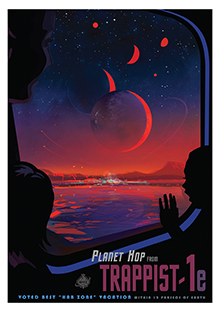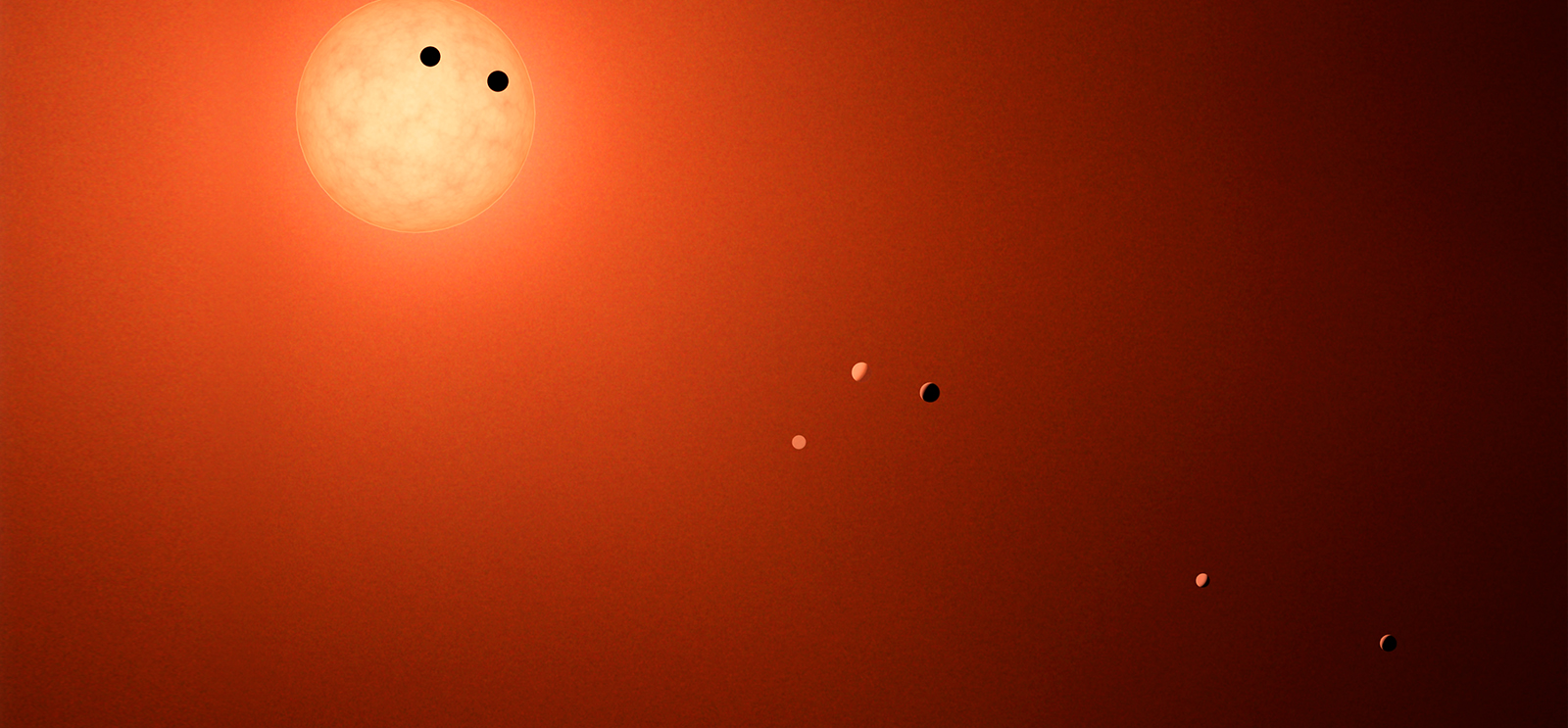This illustration shows seven Earth-sized planets orbiting the TRAPPIST-1 star, as they might look viewed from Earth using a “fictional, incredibly powerful telescope.” The sizes and relative positions are correctly to scale. (NASA/JPL-Caltech)
What you need to know about the seven newly discovered Earth-sized exoplanets.

Last week astronomers announced the discovery of seven Earth-sized planets 40 light-years away (
12 parsecs to
Star Wars fans) orbiting the
ultracool dwarf star
TRAPPIST-1.
Inspired by the findings, Google celebrated the news with an animated
doodle; NASA created a new downloadable
poster for its Exoplanet Travel Bureau series; and some artists even drew
explainers and speculative
concept imagery.
Wanting the scoop from a UChicago
exoplanets expert, the
Magazine reached out to astronomy and astrophysics grad student
Megan Bedell for her reaction to the news. Bedell’s research focuses on finding planets around sun-like stars. She emailed us while sitting only a few yards away from the
TRAPPIST (
TRAnsiting
Planets and
Planetes
Imals
Small
Telescope) in the Chilean desert, as she’s currently at work using another
telescope on the same mountain.
Her comments below have been condensed and edited.

What makes this discovery so important to the scientific community?
Planets as small as Earth are challenging to find, and it’s somewhat unexpected that there would be so many of them in a single system—especially one with such a tiny host star. But the most important thing about this system is that it's an amazing opportunity to study the atmospheres of Earth-like planets elsewhere in the galaxy.
[[{"type":"media","view_mode":"media_original","fid":"3899","attributes":{"alt":"","class":"media-image","height":"333","typeof":"foaf:Image","width":"500"}}]] The TRAPPIST-1 system contains a total of seven planets, all around the size of Earth. (NASA/JPL-Caltech)
How will scientists determine if these exoplanets are habitable?
One big question is whether these planets have substantial atmospheres at all. It may be that their atmospheres have been boiled away by high-energy radiation from the host star since they are located so close to it.
The first step is to see whether any of the planets have retained a significant atmosphere. There are a few subtly different ways to do it, but generally it involves watching the system while the planets orbit around the host star, and looking for small changes in the color and brightness of the system that correspond to the light from the planet’s atmosphere.
Laura Kreidberg [SM’13, PhD’16] actually has some
cool videos explaining these methods.
Then astronomers will look for things like water vapor in the atmosphere and will try to see how thick the atmosphere is (which affects the surface temperature of the planet). The big hope would be to eventually see
biosignatures in the form of, for example, a combination of oxygen and ozone gases that can only be produced by life, but that is probably a long way in the future.
[[{"type":"media","view_mode":"media_original","fid":"3898","attributes":{"alt":"","class":"media-image","height":"251","typeof":"foaf:Image","width":"500"}}]] The TRAPPIST-1 star is orbited by seven Earth-sized planets, NASA announced last week. (NASA/JPL-Caltech)
When might be the soonest that we learn more about these exoplanets?
This system is a perfect target for upcoming missions like NASA’s
James Webb Space Telescope, which aims to observe exoplanet atmospheres in hopes of finding out what kinds of gases they're made of, what their temperature and weather are like, and more. The TRAPPIST-1 system, by virtue of having such a small host star, is the best chance we have for seeing into the atmospheres of Earth-sized exoplanets with the JWST.
What should we keep in mind about this initial news?
As exciting as these planets are, they're just seven out of thousands of exoplanets that have been discovered to date. It’s both scientifically informative and just personally awe inspiring to look at the enormous diversity of planets in our galaxy. I don't think anyone would have predicted that a system like TRAPPIST-1 could even exist a few decades ago.

 Last week astronomers announced the discovery of seven Earth-sized planets 40 light-years away (12 parsecs to Star Wars fans) orbiting the ultracool dwarf star TRAPPIST-1.
Inspired by the findings, Google celebrated the news with an animated doodle; NASA created a new downloadable poster for its Exoplanet Travel Bureau series; and some artists even drew explainers and speculative concept imagery.
Wanting the scoop from a UChicago exoplanets expert, the Magazine reached out to astronomy and astrophysics grad student Megan Bedell for her reaction to the news. Bedell’s research focuses on finding planets around sun-like stars. She emailed us while sitting only a few yards away from the TRAPPIST (TRAnsiting Planets and PlanetesImals Small Telescope) in the Chilean desert, as she’s currently at work using another telescope on the same mountain.
Her comments below have been condensed and edited.
Last week astronomers announced the discovery of seven Earth-sized planets 40 light-years away (12 parsecs to Star Wars fans) orbiting the ultracool dwarf star TRAPPIST-1.
Inspired by the findings, Google celebrated the news with an animated doodle; NASA created a new downloadable poster for its Exoplanet Travel Bureau series; and some artists even drew explainers and speculative concept imagery.
Wanting the scoop from a UChicago exoplanets expert, the Magazine reached out to astronomy and astrophysics grad student Megan Bedell for her reaction to the news. Bedell’s research focuses on finding planets around sun-like stars. She emailed us while sitting only a few yards away from the TRAPPIST (TRAnsiting Planets and PlanetesImals Small Telescope) in the Chilean desert, as she’s currently at work using another telescope on the same mountain.
Her comments below have been condensed and edited.

